Effects of the Structure and Operating Parameters on the Performance of an Electric Scooter
Abstract
:1. Introduction
2. Methodology
2.1. Experimental Setup
2.2. Simulation Modeling
- A Dynamic Model of an Electric Scooter
- Fwrf represents the win resistance force, ;
- Frrf represents the resistance force of rolling friction, ;
- Fsrf represents the resistance force of grade,
- Battery Model
- Scooter Performance
- PID Controller for Controlling Scooter Speed
3. Results and Discussion
3.1. Model Validation
3.2. Effect of Operating and Structure Parameters on Electric Scooter Performance
3.3. Speed Control Results of the Electric Scooter
4. Conclusions
Author Contributions
Funding
Institutional Review Board Statement
Informed Consent Statement
Data Availability Statement
Acknowledgments
Conflicts of Interest
Nomenclature
| M | Total mass of electric scooter and driver, kg |
| x | Moving distance, m |
| Aa | Frontal area, m2 |
| Ca | Aerodynamic drag coefficient |
| ρ | Air density, kg/m3 |
| vw | Velocity of wind, km/h |
| vES | Electric scooter velocity, km/h |
| g | Gravitational of Earth, m/s2 |
| Crr | Coefficient of rolling resistance |
| t | Time, s |
| Rw | Wheel radius, m |
| Vb | Voltage of battery, V |
| E0 | Battery constant voltage, V |
| K | Polarization constant, V/Ah |
| Q | Battery capacity, Ah |
| i(t) | Actual battery charge |
| R | Actual battery charge |
| i | Internal resistance |
| i* | Battery current, A |
| A | Filtered current, A |
| B | Exponential zone amplitude, V |
| Ec | Exponential zone time constant inverse, Ah−1 |
| Ra | The back emf |
| ia | The armature resistance, Ω |
| La | The armature current, A |
| Ua | The armature inductance, H |
| B1 | The terminal voltage of DC motor, V |
| wm | The viscous friction coefficient |
| Te | The speed of motor, rad/s |
| Tm | The electromechanical torque, N.m |
| Ta | The load torque, N.m |
| J | The acceleration torque, N.m |
| Kb | The torque of inertia |
| The torque constant or back emf constant |
References
- Wang, I.K.; Seidle, R. Ambition in innovation: Vicarious learning in the nascent electric scooter market in Taiwan. Technol. Forecast. Soc. Chang. 2020, 152, 119886. [Google Scholar] [CrossRef]
- Liu, Y.; Lai, I.K.W. The Effects of Environmental Policy and the Perception of Electric Motorcycles on the Acceptance of Electric Motorcycles: An Empirical Study in Macau. SAGE Open 2020, 10, 2158244019899091. [Google Scholar] [CrossRef]
- Smith, C.S.; Schwieterman, J.P. E-Scooter Scenarios: Evaluating the Potential Mobility Benefits of Shared Dockless Scooters in Chicago; National Academy of Sciences: Washington, DC, USA, 2018. [Google Scholar]
- National Association of City Transportation Officials (NACTO). Shared Micromobility in the U.S.: 2018; National Association of City Transportation Officials: New York, NY, USA, 2019. [Google Scholar]
- Susan, S.; Adam, C. Shared Micromoblity Policy Toolkit: Docked and Dockless Bike and Scooter Sharing; UC Berkeley: Berkeley, CA, USA, 2019. [Google Scholar]
- Nishad, D.S.; Padhya, H.J.; Gandhi, Z.H. E-Scooter as an Alternative Non-motorized Transport NMT for Urban Area: A case study for Surat City in Gujarat state in western India. Int. J. Res. Anal. Rev. (IJRAR) 2020, 7, 765–767. [Google Scholar]
- Zakhem, M.; Smith-Colin, J. Micromobility implementation challenges and opportunities: Analysis of e-scooter parking and high-use corridors. Transp. Res. Part D Transp. Environ. 2021, 101, 103082. [Google Scholar] [CrossRef]
- Guo, Y.; Zhang, Y. Understanding factors influencing shared e-scooter usage and its impact on auto mode substitution. Transp. Res. Part D 2021, 99, 102991. [Google Scholar] [CrossRef]
- Zhang, W.; Buehler, R.; Broaddus, A.; Sweeney, T. What type of infrastructures do e-scooter riders prefer? A route choice model. Transp. Res. Part D 2021, 94, 102761. [Google Scholar] [CrossRef]
- Henna, S.-A.; Anu, T.; Heidi, A.; Petri, T. Sustainability and the Contribution of Electric Scooter Sharing Business Models to Urban Mobility. Built Environ. 2021, 47, 541–558. [Google Scholar]
- Cao, Z.; Zhang, X.; Chua, K.; Yu, H.; Zhao, J. E-scooter sharing to serve short-distance transit trips: A Singapore case. Transp. Res. Part A 2021, 147, 177–196. [Google Scholar] [CrossRef]
- Nikiforiadis, A.; Paschalidis, E.; Stamatiadis, N.; Raptopoulou, A.; Kostareli, A.; Basbas, S. Analysis of attitudes and engagement of shared e-scooter users. Transp. Res. Part D 2021, 94, 102790. [Google Scholar] [CrossRef]
- Campisi, T.; Basbas, S.; Skoufas, A.; Tesoriere, G. Socio-Eco-Friendly Performance of E-Scooters in Palermo: Preliminary Statistical Results. Innov. Urban Reg. Plan. 2021, 1, 643–653. [Google Scholar]
- Akgu, N.; Campisi, T.; Tanbay, T.; Tesoriere, G.; Dissanayake, D. Modelling Road User Perceptions towards Safety, Comfort, and Chaos at Shared Space: The via Maqueda Case Study, Italy. J. Adv. Transp. 2022, 2022, 4979496. [Google Scholar]
- Yang, H.; Huo, J.; Bao, Y.; Li, X.; Yang, L.; Cherry, C.R. Impact of e-scooter sharing on bike sharing in Chicago. Transp. Res. Part A Policy Pract. 2021, 154, 23–26. [Google Scholar] [CrossRef]
- Severengiz, S.; Schelte, N.; Bracke, S. Analysis of the environmental impact of e-scooter sharing services considering product reliability characteristics and durability. Procedia CIRP 2021, 96, 181–188. [Google Scholar] [CrossRef]
- Xue, Q.; Li, G.; Zhang, Y.; Shen, S.; Chen, Z.; Liu, Y. Fault diagnosis and abnormality detection of lithium-ion battery packs based on statistical distribution. J. Power Sources 2021, 482, 228964. [Google Scholar] [CrossRef]
- Lee, S.Y. Numerical Analysis on development of the Cooling System for E-Scooter Battery Pack. J. Energy Eng. 2016, 25, 30–36. [Google Scholar] [CrossRef] [Green Version]
- Wangsupphaphol, A.; Chaitusaney, S.; Salem, M. A Techno-Economic Assessment of a Second-Life Battery and Photovoltaics Hybrid Power Source for Sustainable Electric Vehicle Home Charging. Sustainability 2023, 15, 5866. [Google Scholar] [CrossRef]
- Das, H.S.; Nurunnabi, M.; Salem, M.; Li, S.; Rahman, M.M. Utilization of Electric Vehicle Grid Integration System for Power Grid Ancillary Services. Energies 2022, 15, 8623. [Google Scholar] [CrossRef]
- Song, B.-M.; Choi, J.-Y. A Low-Speed High-Torque Permanent Magnet Motor for Electric Scooters. In Proceedings of the IEEE Vehicle Power and Propulsion Conference, Chicago, IL, USA, 6–9 September 2011; pp. 1–6. [Google Scholar]
- Yang, Y.-P.; Liu, J.-J.; Hu, T.-H. An energy management system for a directly-driven electric scooter. Energy Convers. Manag. 2011, 52, 621–629. [Google Scholar] [CrossRef]
- Yuniarto, M.N.; Rijanto, E.; Mukhlisin, A. Design and Performance Analysis of Brushless Direct Current (BLDC) Motor Controller for Electric Scooter. IOP Conf. Ser. Mater. Sci. Eng. 2019, 694, 012004. [Google Scholar] [CrossRef]
- Yuniarto, M.N.; Wiratno, S.E.; Nugraha, Y.U.; Sidharta, I.; Nasruddin, A. Modeling, Simulation, and Validation of An Electric Scooter Energy Consumption Model: A Case Study of Indonesian Electric Scooter. IEEE Access 2022, 10, 48510–48522. [Google Scholar] [CrossRef]
- Hieu, L.-T.; Khoa, N.X.; Lim, O.T. An Investigation on the Effects of Input Parameters on the Dynamic and Electric Consumption of Electric Motorcycles. Sustainability 2021, 13, 7285. [Google Scholar] [CrossRef]
- Hieu, L.T.; Khoa, N.X.; Lim, O.T. An investigation on the effective performance area of the electric bicycle with variable key input parameters. J. Clean. Prod. 2021, 321, 128862. [Google Scholar] [CrossRef]
- Yildiz, A.B. Electrical equivalent circuit based modeling and analysis of direct current motors. Electr. Power Energy Syst. 2012, 43, 1043–1047. [Google Scholar] [CrossRef]
- Abagnale, C.; Cardone, M.; Iodice, P.; Strano, S.; Terzo, M.; Vorraro, G. Derivation and Validation of a Mathematical Model for a Novel Electric Bicycle. In Proceedings of the World Congress on Engineering, London, UK, 1–3 June 2015; Volume 2. [Google Scholar]
- Tremblay, O.; Dessaint, L.-A. Experimental Validation of a Battery Dynamic Model for EV Applications. World Electr. Veh. J. 2009, 3, 289–298. [Google Scholar] [CrossRef] [Green Version]
- Patil, P.J.; Koujalagi, J.P. Modeling of BLDC motor powered from Li-ion battery for electric bicycle application. Int. J. Res. Sci. Adv. Technol. 2014, 2, 47–53. [Google Scholar]
- Ang, K.H.; Chong, G. PID control system analysis, design, and technology. IEEE Trans. Control Syst. Technol. 2005, 13, 559–576. [Google Scholar]
- Tang, K.Z.; Huang, S.N.; Tan, K.K.; Lee, T.H. Combined PID and adaptive nonlinear control for servo mechanical systems. Mechatronics 2004, 14, 701–714. [Google Scholar] [CrossRef]

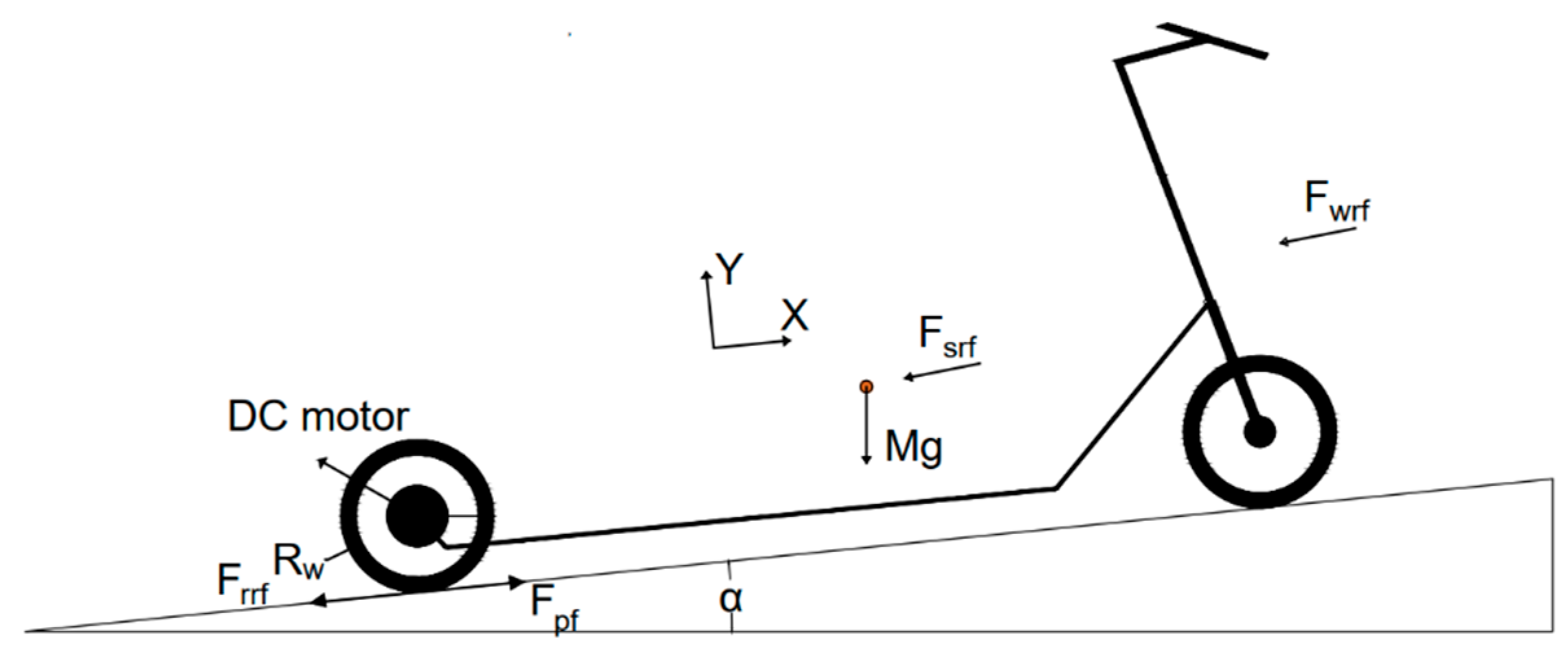





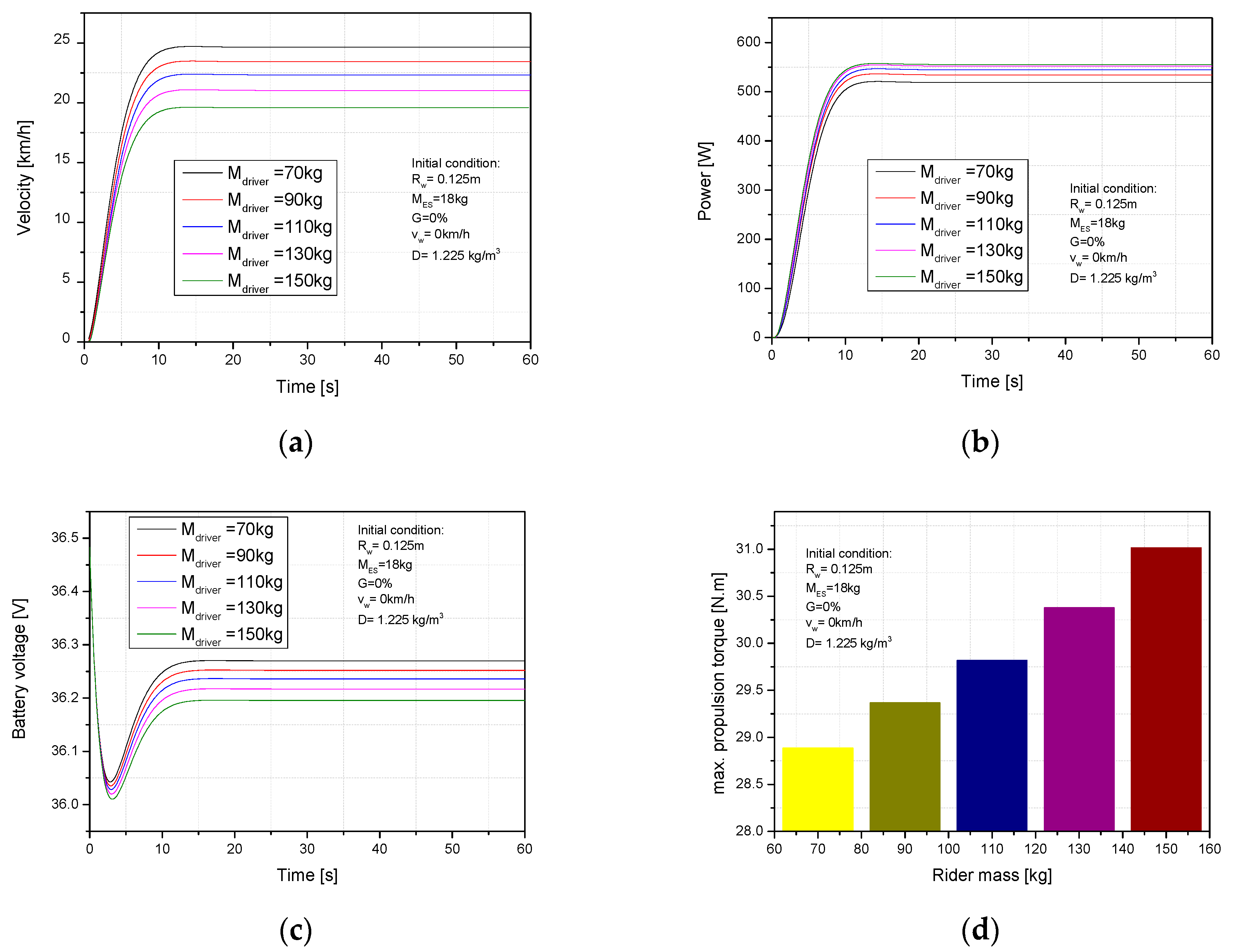


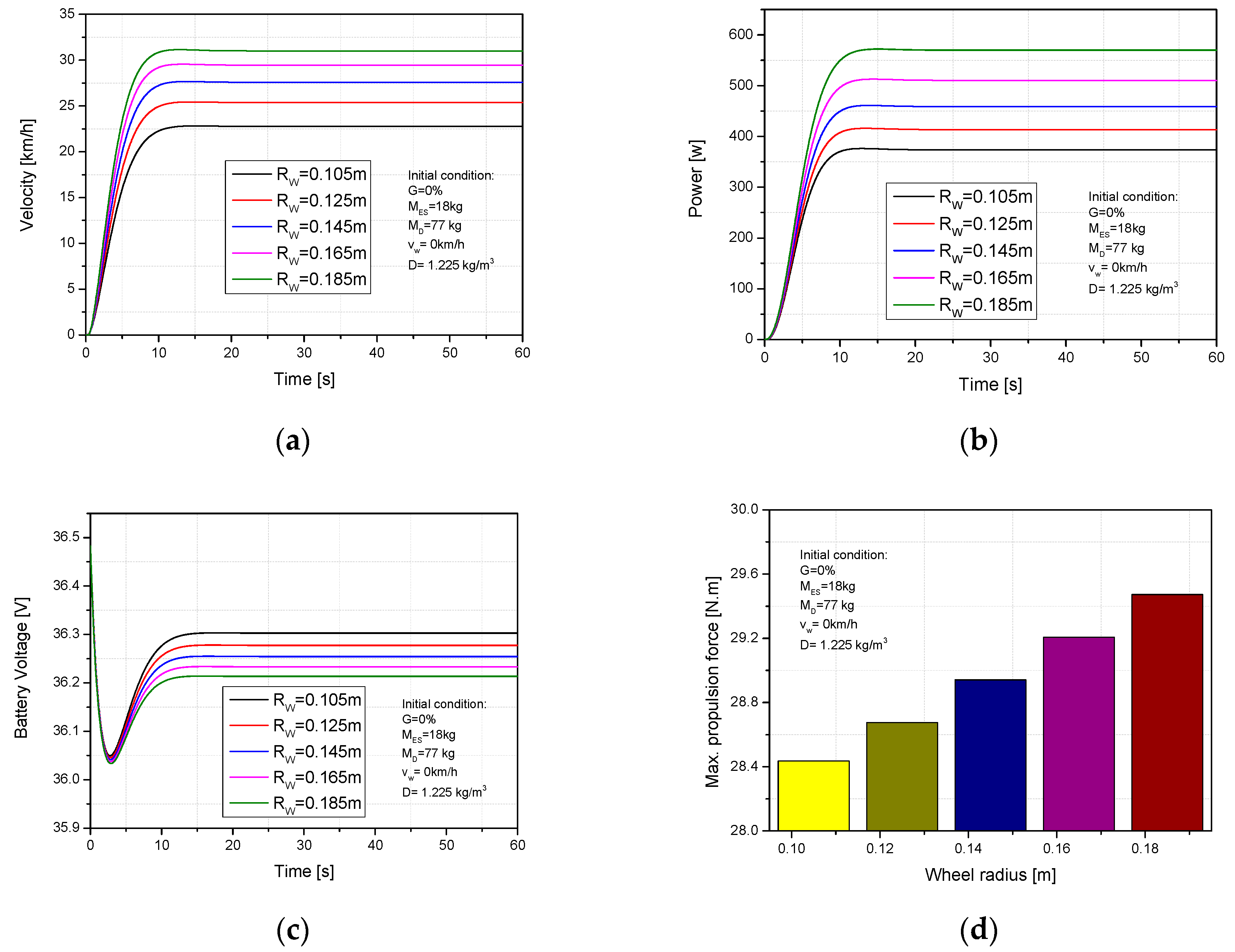


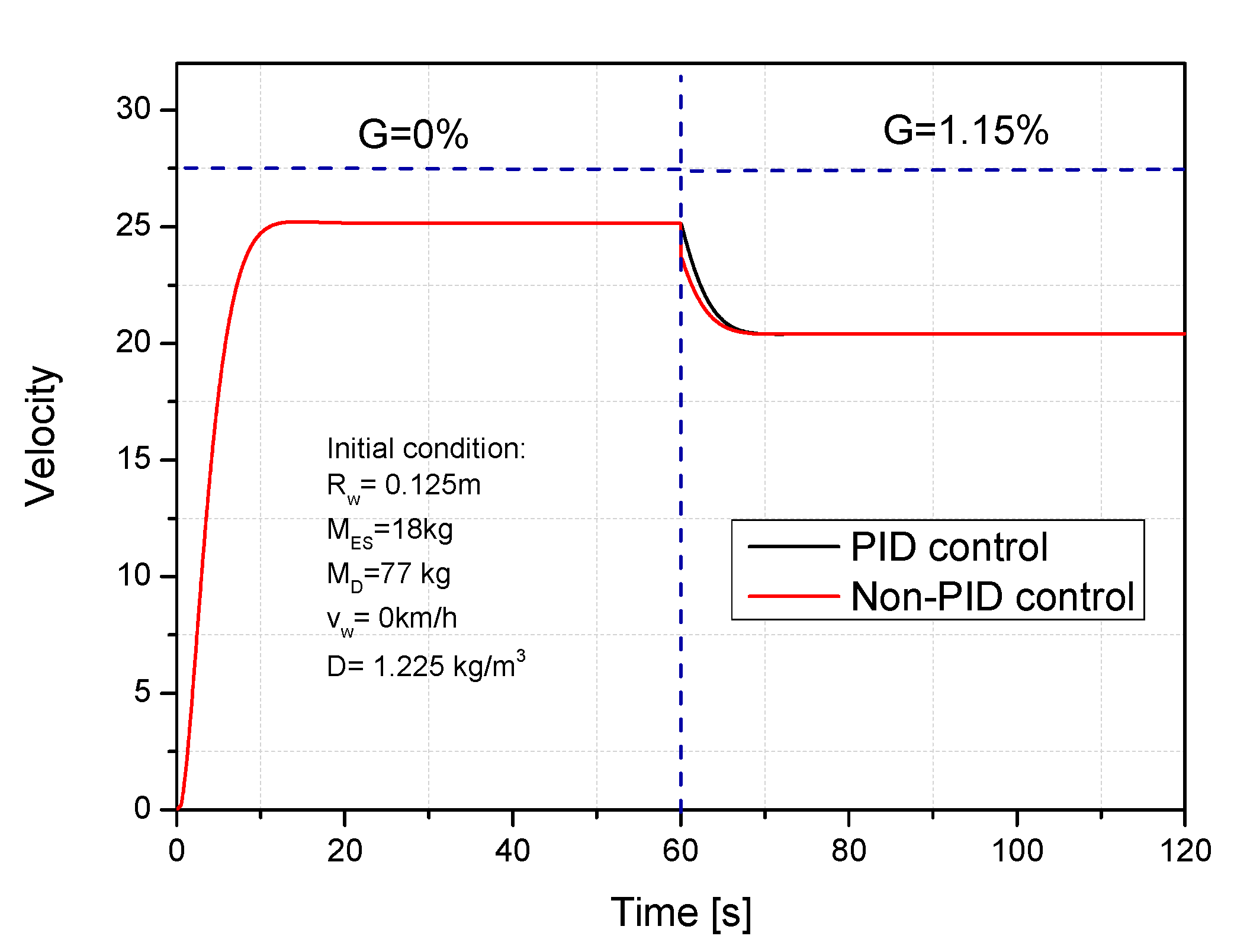
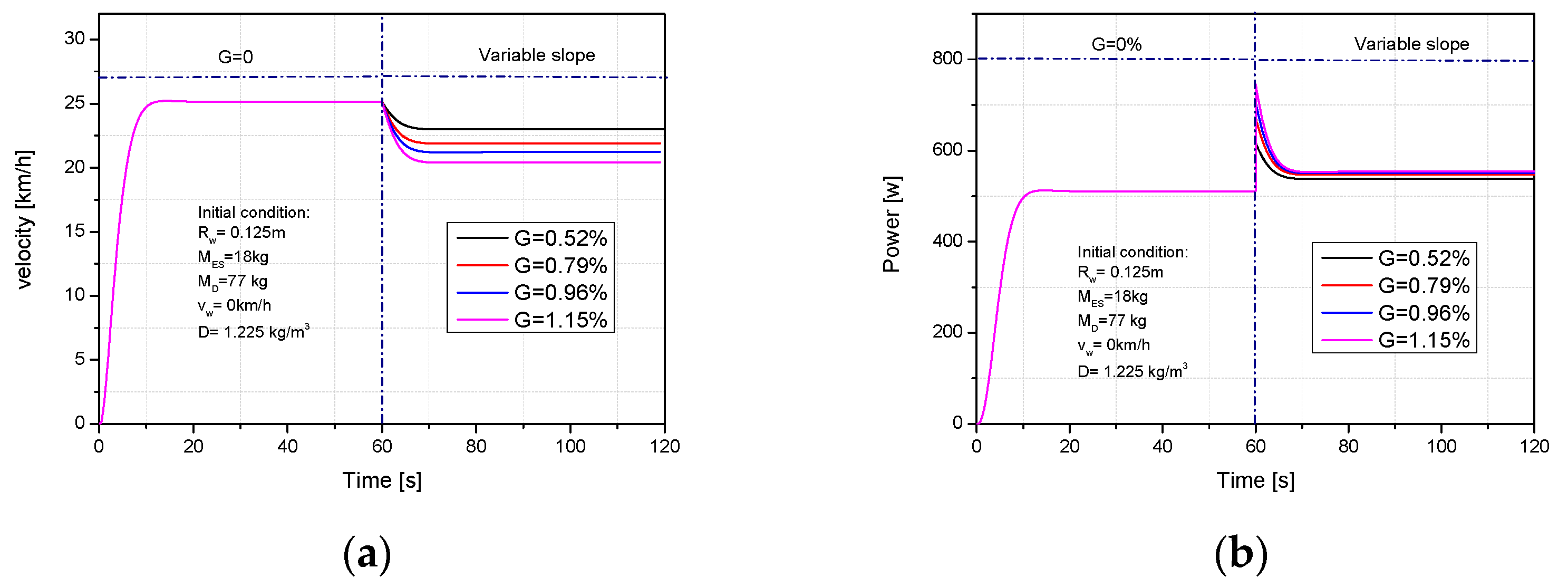

| Reference | Proposed | Finding | Limitation |
|---|---|---|---|
| Zhejing Cao et al., 2021 [11] | Survey on electric scooter users in the Central Area of Singapore. | Longer access/egress walking, more transfer, and a higher level of transit indirectly led to increasing probability of use of electric scooters. | The study focused specifically on the Central Area Singapore and may not be fully representative of other areas. |
| Andreas Nikiforiadis et al., 2021 [12] | Survey of 307 e-scooter users to understand the operation of e-scooters and the profile of their users. | Shared e-scooters primarily replaced walking and public transport trips. Gender affected e-scooter use. | The research was conducted only in Thessaloniki, Greece. |
| Nurten Akgün -Tanbay et al., 2022 [14] | Survey of 200 participants on influence of perception of infrastructure, frequency of road use, and road user perception on safety, comfort, and chaos in shared spaces. | A higher perception of infrastructure positively impacted the safety and comfort perceptions of both walking and cycling. | The sample size was relatively small. The study does not investigate actual safety incidents or objective measures of comfort and chaos in shared spaces. |
| Hongtai Yang et al., 2021 [15] | Analysis of electric scooter sharing on bike sharing in Chicago over a period of 30 weeks. | The introduction of electric scooter sharing had a negative impact on bike sharing. | The analysis was conducted over a relatively short period of 30 weeks. The study didn’t examine the satisfaction or experiences of e-scooter users or bike sharing users. |
| Semih Severengiz et al., 2021 [16] | A life cycle assessment methodology to evaluate the environmental impact of electric sharing services with a focus on ecological sustainability. | Upgrading the battery technology of electric scooters can lead to a reduction in global warming potential. | Other dimensions of sustainability, such as social and economic aspects, were not considered. |
| Aree Wangsupphaphol et al., 2023 [19] | Examining the use of retired electric vehicle batteries for stationary energy storage in residential households. | Using a retired battery with a depth of discharge of 85% for stationary energy storage offers advantages over using a new battery with similar characteristics. | Lacked practical implementation to address these challenges and assess their feasibility. |
| Muhammad Nur Yuniarto et al., 2022 [24] | Developing of an electric scooter model to simulate its performance, particularly focusing on range estimation. | The developed electric scooter model is valid and has a satisfactory level of accuracy in predicting energy consumption by reducing 89% energy cost compared with internal combustion engines in a ride-hailing application. | The study focuses primarily on the energy consumption model of the electric scooter and its performance comparison with internal combustion engine scooters. |
Disclaimer/Publisher’s Note: The statements, opinions and data contained in all publications are solely those of the individual author(s) and contributor(s) and not of MDPI and/or the editor(s). MDPI and/or the editor(s) disclaim responsibility for any injury to people or property resulting from any ideas, methods, instructions or products referred to in the content. |
© 2023 by the authors. Licensee MDPI, Basel, Switzerland. This article is an open access article distributed under the terms and conditions of the Creative Commons Attribution (CC BY) license (https://creativecommons.org/licenses/by/4.0/).
Share and Cite
Hieu, L.T.; Lim, O.T. Effects of the Structure and Operating Parameters on the Performance of an Electric Scooter. Sustainability 2023, 15, 8976. https://doi.org/10.3390/su15118976
Hieu LT, Lim OT. Effects of the Structure and Operating Parameters on the Performance of an Electric Scooter. Sustainability. 2023; 15(11):8976. https://doi.org/10.3390/su15118976
Chicago/Turabian StyleHieu, Le Trong, and Ock Taeck Lim. 2023. "Effects of the Structure and Operating Parameters on the Performance of an Electric Scooter" Sustainability 15, no. 11: 8976. https://doi.org/10.3390/su15118976
APA StyleHieu, L. T., & Lim, O. T. (2023). Effects of the Structure and Operating Parameters on the Performance of an Electric Scooter. Sustainability, 15(11), 8976. https://doi.org/10.3390/su15118976





